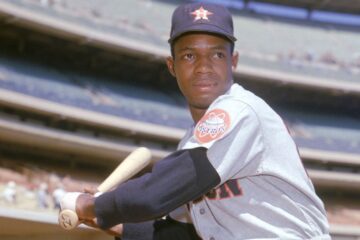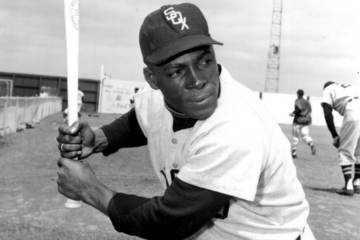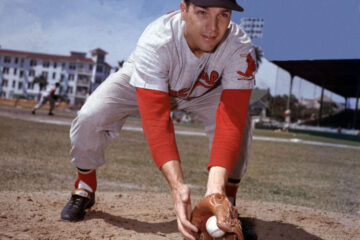The Hall of Fame Index: Who is the most qualified center fielder not in the Hall of Fame?
One of the obstacles we encounter with analysis is overcoming the notion that all skills are created equal. Scouts begin this with the so-called five tools. Each tool is treated as sacrosanct and it those five tools even leaves out the most valuable tool on top of that (plate discipline). A book like The Hall of Fame Index Part II tries to look at who the most valuable player is at any particular position. In order to make such comparisons we must free ourselves of the notion that all skills are created equal.
This becomes important when comparing center fielders on the outside looking in. If we evaluate players the old-fashioned way we will miss the most qualified player at the position. We might end up supporting a qualified candidate, but we miss greatness. This is because some players that are great are not great at every skill. They are flawed players, but they possess an overabundance of the skills necessary to accrue value. This will become readily apparent when we break down the numbers.
Career Value
| BWAR | FWAR | WS/5 | Total | |
| Kenny Lofton | 68.4 | 62.4 | 57.4 | 188.2 |
| Jim Edmonds | 60.4 | 64.5 | 60.2 | 185.1 |
| Andruw Jones | 62.7 | 67.0 | 55.2 | 184.9 |
| Willie Davis | 60.8 | 53.7 | 64.4 | 178.9 |
There is no greater red herring than the notion of base running as a valuable skill. I shudder to use words like important because it is imprecise language. It is important not to create outs on the bases. Value is more precise language. The relative value of gaining an extra base is mitigated by the risk of creating an extra out. Baseball commentators have talked themselves in knots trying to claim that slow baserunners cost their team runs. This is true on a literal level, but when it is posited (as it was on ESPN) that Frank Thomas clogged the bases every time he walked it is enough to make you yell at your television.
The single most valuable skill in baseball is the ability to steal first base. The second and third most valuable skills are the ability to hit for extra bases and the ability to create more outs while in the field. I’m sure the mathematicians out there can break that down to a more exact percentage than I could, but the ability to take extra bases with your feet comes in a distant fourth.
This becomes important when we compare the likes of Lofton and Davis with Jones and Edmonds. The last two were seen as imperfect players. They didn’t bring the speed game that the other two did. As we will see, that actually matters little and their fielding contributions are much more valuable. It is also the main reason why we stick to terms like valuable. I’m not a baseball coach, so I’m not going to throw around words like important.
Peak Value
| BWAR | FWAR | WS/5 | Total | Index | |
| Jones | 57.9 | 61.0 | 44.2 | 163.1 | 348.0 |
| Edmonds | 51.7 | 53.5 | 46.6 | 151.8 | 336.9 |
| Lofton | 52.6 | 47.5 | 40.4 | 140.5 | 328.7 |
| Davis | 43.2 | 38.0 | 42.8 | 124.0 | 302.9 |
The creators of WAR and win shares have done two crucial things. First, they have managed to have taken each skill and calculate how each player contributed to their team’s success in that particular skill. More importantly, they have reverse engineered the history of the game to the point where they can tell you relatively how each skill interacts with each other to bring their value in proportion. In other words, they can tell you how much more value power brings mathematically than speed. They can do this in exact numbers.
It is true that all four players above will see adjustments in their career and peak value over time. This is the main reason why I don’t set arbitrary marks for who is in and who isn’t. It’s more important to see how each player interacts with those around them. The appreciable difference between Lofton and Edmonds is not much. It is close enough to where their positioning could shift. However, the formulas are stable enough to where there will not be a ton of shifting one way or another.
This is where the offensive and fielding numbers come in. They do two things. First, they help explain partially why each player got the value score they did. They leave out the important element of time, but you can at least see each skill broken down to its foundation to see how much value they add or subtract from that particular player.
Offensive Numbers
| OPS+ | Rbaser | OW% | wOBA | |
| Edmonds | 132 | -11 | .659 | .385 |
| Jones | 111 | 9 | .554 | .352 |
| Lofton | 107 | 79 | .582 | .352 |
| Davis | 106 | 63 | .536 | .321 |
So, there are 90 runs difference on the bases between Edmonds and Lofton. Over a 15 year career that winds up being six runs per season. This becomes important when we look at counting numbers. Lofton stole 622 bases in his career. For some, that will add a ton to his profile. However, as we can see it didn’t really add a ton to his value. Moreover, he stole bases at a nearly 80 percent clip in his career. That makes him one of the more efficient base stealers in history. That’s great, but in the grand scheme things, it doesn’t matter nearly as much as Edmonds combined ability to get on base and hit for power.
Lofton’s totals give him an advantage over Davis, but as we can see with the Rbaser, that advantage is relatively limited. Rbaser is baseball-reference’s number. Baseball Prospectus and Fangraphs have their own numbers as well. Bill James online also has their own analysis for current players. It’s all very nice and interesting, but we can get lost in the weeds of analysis that just doesn’t matter that much in the grand scheme of things.
Fielding Numbers
| Rfield | DWAR | TZOF | DWS/5 | |
| Jones | 235 | 24.4 | 276 | 18.1 |
| Lofton | 108 | 15.5 | 114 | 12.5 |
| Davis | 104 | 11.1 | 106 | 15.7 |
| Edmonds | 37 | 6.4 | 58 | 12.5 |
These breakdowns are valuable for a couple of reasons, First, they clear up some misconceptions. A bunch of us grew up watching Jim Edmonds make amazing diving catches on Sportscenter. There were a couple of diving over the shoulder catches that rivaled anything we’ve seen in grainy Willie Mays videos. These numbers show us that the legend of Edmonds is more myth than fact. There is nothing wrong with being 37 or 58 runs above average. That’s obviously better than most center fielders. It doesn’t hold a candle to Jones.
Jones wasn’t on Sportscenter every night. He made the plays look easy with an impressive first step that was the most efficient use of his athleticism nine times out of ten. We ironically see that Lofton was valuable, but not for the reasons we thought. He got on base and he took more outs away than the vast majority of center fielders. The same is true of Davis.
Jones led the league four times in five season in defensive WAR. That’s not center fielders. That’s EVERY SINGLE PLAYER. He led in total zone runs six different times at all positions and amongst center fielders six times. He led in putouts six times as well. He led in assists during three seasons. He was a regular center fielder for only 11 seasons. It is fair to question his longevity, but we have dramatically undersold his impact defensively.
Playoff Numbers
| PA | SLASH | HR | Runs | RBI | SB | |
| Lofton | 438 | .247/.315/.352 | 7 | 65 | 34 | 34 |
| Jones | 279 | .273/.363/.433 | 10 | 43 | 34 | 5 |
| Edmonds | 263 | .274/.361/.513 | 13 | 33 | 42 | 2 |
| Davis | 62 | .179/.190/.232 | 0 | 6 | 3 | 3 |
There is a difference between valuable information and trivia. My wife is fond of calling trivia RAS (random ass statistics). These are the ones the television broadcasters tell. For instance, Jose Altuve is the only player under five foot six to hit multiple home runs in a postseason game while also being from another country. If you add enough qualifiers you can make anything sound impressive.
Kenny Lofton has more steals in the playoffs than any player in history. The question is whether that is an impressive achievement or something you mind find on the back of a Trivial Pursuit card. Look at everything else and it tells that Edmonds has the most impressive postseason record. Jones also has an impressive record. Take away those steals and Lofton just doesn’t look that good.
We always have the debate of how much the postseason should count anyway. I’ve always been a big Edmonds backer and this is one of the main reasons why. He was a prominent member of some really good Cardinals teams in the 2000s. As to whatever extent clutch performance exists with the bat or glove, he seemed to possess it. Whether that is enough to leapfrog Lofton is up the individual voter obviously.
BWAR MVP Points
| Top 10 | Top 5 | MVP | PTS | |
| Jones | 2 | 4 | 0 | 26 |
| Lofton | 2 | 2 | 1 | 26 |
| Edmonds | 4 | 1 | 0 | 17 |
| Davis | 2 | 1 | 0 | 11 |
Jones is in a different position than the other three. He is still on the BBWAA ballot and almost earned 20 percent of the vote in his third year. He has ten years on the ballot, so he will need a significant bump in order to gain enough steam to be put in by the writers. More information is being put forth every day and the electorate turns over slightly every year. More and more new voters give him a better chance because newer voters are usually more in tuned to statistical analysis.
The other three will need to be considered by the other three. Lofton and Edmonds are both modern guys, so they will be competing to get on the same Veterans Committee ballot. They are close across the board in terms of value. Do you give the edge to the better big game performer, or do you give the slight edge to the player that performed better here? I’m lucky enough not to have a vote. If you put a gun to my head I’d probably support Lofton first, but I wouldn’t fault either guy.
Davis obviously is in a different era and a different category. As someone that has an index score over 300 he is technically qualified in the strictest sense, but he is in the same neighborhood as guys like Jimmy Wynn, Cesar Cedeno, or Vada Pinson. They are all good and certainly could be qualified in some sense, but are they more qualified than others on the outside looking in? That’s a high bar to clear.





